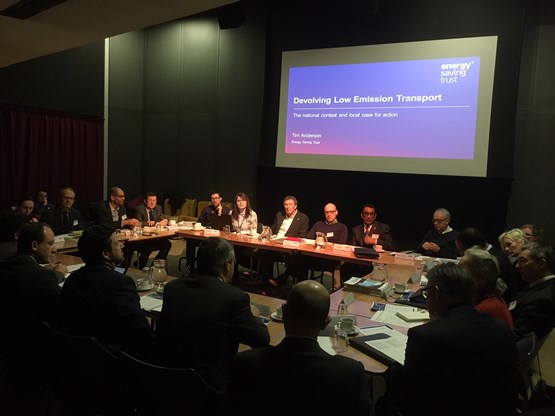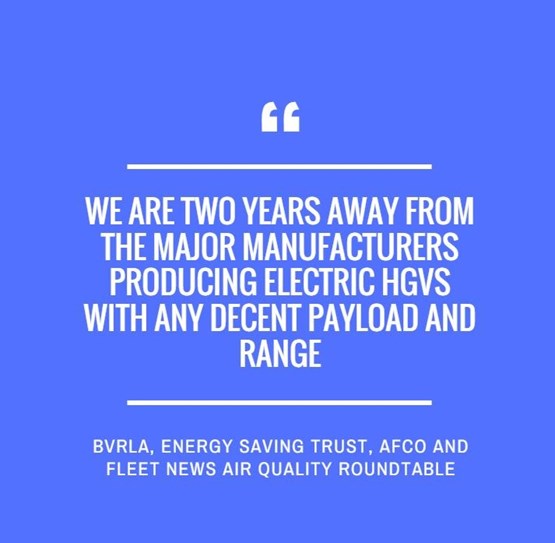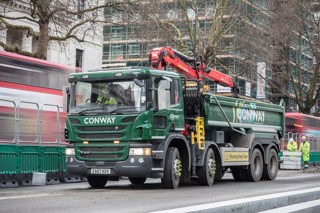Three city councils are adopting different strategies, causing concern for those with nationwide fleet operations who need consistency.
Two messages dominated the three Clean Air Zone (CAZ) roundtables jointly hosted by British Vehicle Rental and Leasing Association (BVRLA), Energy Saving Trust (EST), ACFO and Commercial Fleet sister publication Fleet News: fleets need a consistent approach from all the cities introducing clean air zones and local authorities must have a clear communications plan.
Fleet decision-makers, leasing companies and industry representatives came together at separate meetings with councillors from the city councils of Leeds, Nottingham and Derby to discuss proposed moves to tackle air quality issues.

Each council had its own take on what was required to meet the air quality standards and they were at different stages in the process, despite all having to issue their proposals to Government as Commercial Fleet went to press.
The Government-mandated CAZs in Birmingham, Derby, Leeds, Nottingham and Southampton fall under a loose ‘class’ framework, but each of the five cities is working on its own solutions.
There is some cooperation and sharing of ideas, but not enough in the view of some roundtable attendees.
Leeds City Council is leading the way, having published its consultation document in January.
READ MORE: Derby City Council favours scrappage scheme over CAZ charge, third air quality debate reveals
“We have a massive challenge we are facing as a city,” said councillor Lucinda Yeadon, deputy leader and executive member for environment and sustainability, Leeds City Council.
“Legal compliance is one thing, but this is a health issue and we have a moral responsibility to do something.”
Leeds claims to have the largest electric vehicle fleet of any local authority in England with 100 EVs and it is developing an alternative fuel site in the city for compressed natural gas, electric and, eventually, hydrogen that can be used by business and the public, as well as its own vehicles.
Following extensive modelling, the council opted for CAZ Class B, which it believes will achieve its targets if combined with other measures, such as moving the taxi fleet to electric and hybrid cars.
The charging structure, based on the Transport for London scheme of £100 per day for HGVs, is intended to drive cleaner vehicle uptake.

As such, given that the emissions difference between Euro 3 and Euro 6 is so great, the council is considering a tapered CAZ charge.
Its investment in the scheme will be substantial: the scale of infrastructure includes approximately 476 signs and 326 cameras, for example.
While fleets welcomed Leeds City Council’s measured approach to air quality, they voiced concerns about the various local authorities across the UK working in isolation.
“We need consistency between CAZs throughout the country,” said one.
“Signage, charges and system operations should all be common between CAZ cities in order to reduce disruption and confusion on the part of fleet operators.”
Another fleet operator pointed to the difficulties commercial fleet operators have in changing or amending their vehicle replacement cycles.

Many buy vans and HGVs to be operated over the next six or seven years – and for some, particularly large trucks, this could be up to 12 years.
However, operators must respond to new standards being set by city authorities which are to be implemented within two years.
City councils should therefore involve, engage with and support fleet operators as much as possible, if the goal is to achieve maximum improvements in air quality.
The BVRLA called for greater support for commercial vehicle operators as “they will struggle the most”, but also urged Government to amend its low emission vehicle incentives to last the lifetime of the vehicle, not just the first owner.
Support from the council can take many forms. For example, some commercial fleets are constrained by grid restrictions as to the number of charging points they can install, which, in turn, affects the number of EVs they can buy and operate.
READ MORE: Birmingham City Council criticised over ‘lack’ of air quality plan progress
Others, who lease their premises, require registered landlord consent to make changes such as EV charging point installation. Assistance from the council can make a big difference in overcoming such regulatory obstacles.
While the Leeds proposals are intended to tackle vehicles entering the city centre, some fleet operators with distribution centres just inside the proposed zone raised the prospect of exemptions when their vehicles are travelling away from the centre towards the motorway.
In addition, to help reduce business disruption, the CAZ should allow a sunset clause that gives small- and medium-sized businesses (SMEs) more time to be become compliant.

It should also provide additional flexibility and support for businesses that face particular challenges in upgrading their fleet (examples of support could include retrofitting grants or van permits).
Such recommendations were also made to councillors from Nottingham and Derby city councils. Both are lagging behind Leeds with their CAZ proposals.
However, Nottingham City Council believes it is starting from a position of strength due to previous actions introduced to address congestion and emissions in the city centre, including the workplace parking levy and investment in a comprehensive tram service.
Councillors claim that, should they take no additional action, Nottingham will meet its air quality obligations by 2024 at the latest.

Nevertheless, like Leeds, doing nothing is not an option. Instead, it has assessed a number of models that would bring the city into line before then and, like Leeds, is favouring the Class B option.
This disappointed truck operators and funders who felt car owners should also be part of the solution. They also called for incentives to help them invest in compliant vehicles.
Nottingham councillor Sally Longford said: “We are looking at Class B because the major problem is trucks and buses – we’ve been steered towards that (by central Government). We are already charging car drivers who come into the city and park at their place of work.”
She added: “We are still running our models but we acknowledge that we need to have consistency with other cities.
"We have funding through the clean air fund and we will see how we can help HGV operators, especially smaller fleets, but compliance looks like Euro 6 diesel and Euro 4 petrol.”
Despite acknowledging the need for consistency, Nottingham has not entered into detailed discussions with the other cities that are introducing CAZs – although it has had several approaches to discuss its workplace parking levy. Instead, it is calling for leadership at a national level.
READ MORE: Nottingham's parking levy provides air quality advantage, roundtable reveals
“It’s up to central Government to set up an agreed platform upon which we can all operate, otherwise we will end up with different systems,” Longford said.
When questioned over its CAZ objectives, the council was clear that its goal was solely to reduce emissions – not to generate a profit. Any surplus would be reinvested into further measures to improve air quality.
Would the council consider shutting the CAZ in 2024 if its modelling showed the city would be compliant by then? This would influence fleets’ business decisions as the measures would only be viable for a few years.
No, came the reply, the zone would not be disbanded. In fact, all the indications are that the limits for compliant vehicles will become more stringent over time.
“There will still be nitrogen oxide in the air and CAZs will continue to play a role in improving quality in the future,” said James Ashton, transport strategy manager at Nottingham City Council.
“There is no safe level for particulate matter but if we encourage people into clean vehicles then the problem goes away.”
Nottingham is already looking beyond CAZ policies to create an environment for cleaner motoring.

Measures include the introduction of a lane dedicated to ULEVs and parking incentives through the Ringo scheme for local authority car parks.
While Leeds and Nottingham are committed to a charging CAZ, Derby City Council is taking an opposing view and has no plans to “voluntarily” charge for any vehicles entering the city centre.
Councillors are confident they can meet their air quality obligations through a series of alternative measures.
One of the reasons for this position is their belief that the cost of regularly paying the CAZ charge may be prohibitive for those who cannot afford to upgrade their vehicle to a compliant Euro 6 diesel, Euro 4 petrol or electric/hybrid, either through retrofit or buying a new vehicle.
For company employees, the CAZ charge will simply be reclaimed on expenses and might actually be less costly than changing the vehicle.
“We don’t think that it’s necessarily a directly effective measure,” said Nigel Brien, head of traffic and transportation at the Derby council. “It’s blunt tool that could have unintended consequences.”
Councillor Asaf Afzal, cabinet member for neighbourhoods and public protection, acknowledged the concerns about air pollution and said it was something the council was taking very seriously.
But, he stated: “Charging is not a compulsory part of clean air zones, so a charging scheme will not be voluntarily introduced in this city. We can achieve specific levels through a range of other measures, such as public transport and cleaner vehicles.”
READ MORE: Fleets urge local authorities for air quality consistency, at Leeds Council roundtable
Alternative measures include investing £2.5 million from the clean bus technology fund to retrofit 150 buses, which will reduce tailpipe emissions “by up to 90%”, the installation of more electric vehicle charging points and promoting a healthier lifestyle through sport and cycling.
Derby City Council has calculated it would cost £5 million in public money to establish a charging zone in the inner city, but the Defra modelling on air quality suggests the city could be compliant by 2022/23 regardless of any action.
It has isolated issues on ring roads, with the worst at 43microgrammes (based on its own measurements) – just above the 40microgrammes limit. These problems will be resolved through targeted road schemes.
There was universal agreement that Government needs to amend planning laws for new housing estates to encourage installation of EV charging points. Derby wants greater powers to mandate new charging points.
Lorna McAtear, head of supply and internal accounts at Royal Mail, underlined one of the issues for companies that lease their premises: “We have already put six electric vans into Derby. Our wider challenge is planning for charging points when you are not the landlord.”
Fleets and leasing companies raised concerns about the lack of vans on the market with a range of more than 100 miles, although some are being trialled in Europe. Greater pressure and support needs to be put on manufacturers to provide better, commercially feasible vans and HGVs that can work for fleet operators.
One fleet said: “We are two years away from the major manufacturers producing electric HGVs with any decent payload and range.”
Fleet sector’s four policy proposals
- Incentivise fleets to operate outside times of heavy traffic to minimise congestion. For example, fleet vehicles could be allowed to enter the CAZ without charge between 11pm to 5am.
- Consistent methods of charging is key. A single portal could be developed that would allow commercial fleets to pay for non-compliant vehicles entering several zones in one day at the same time.
- Ex-fleet vehicles are typically lower in emissions than their average counterparts on UK roads. A website could be developed to enable BVRLA members to sell vehicles directly to local businesses, thereby moving the greenest vehicles to businesses requiring road transport.
- Provide mobility credits, redeemable on public transport, car rental, car clubs, or other forms of greener travel, to drivers giving up older, more polluting diesel vehicles. Funding from the Government’s Clean Air Fund.
Neil Evans, director of resources and housing, Leeds City Council
Leeds City Council considered three options to meet its air quality obligations.
Option one was no CAZ and non-charging interventions, such as park and ride. Modelling showed improvements in air quality, but it didn’t achieve compliance.
Option two was an inner ring-road CAZ. However, modelling showed this would result in vehicle displacement into inner city communities, as much as three times in some areas. It also didn’t achieve compliance.
The council opted for option three, an outer ring-road/motorway network zone.
“Everything within this would be subject to charge,” said Neil Evans. “It leads to little vehicle displacement, it’s a model that people will understand and it improves health in a wider area.”
He considered CAZ Class D – charging all types of non-compliant vehicle from trucks through to motorcycles. It would achieve the air quality standard but there were economic implications.
Class D would encompass 500,000 cars, 120,000 vans and 40,000 trucks but, by 2020, just 44% of diesel vans and cars would be compliant (Euro 6 diesel or Euro 4 petrol).
“This is an option that we don’t want to go down,” said Evans. “Instead, we propose CAZ B.”
There is one issue: Class B brings most areas under the air quality limits, but not all; therefore, Class B marginally fails. It requires additional measures to ensure compliance.
“The additional measures include encouraging voluntary movement to alternative vehicles and moving private taxis from Euro 6 to hybrid and electric,” said Evans.
“This equates to 5,000 vehicles and 50,000 miles a year – the impact is significant.”
The council has applied for £1.9 million of funding from Government to invest in an electric infrastructure and it will embark upon a communications campaign to promote the benefits of switching to electric – estimated by Energy Saving Trust to save £100 in refuel costs for every 1,000 miles driven.
The council also recognises that, for HGVs, there are supply shortages due to the high demand for Euro 6, and there is a lack of retrofit solutions for non-compliant trucks to meet the standard – 20% are expected to be non-compliant in Leeds by 2020.
“We are lobbying Government to accelerate retrofit options,” Evans added.
James Ashton, transport strategy manager, Nottingham City Council
Government modelling suggests the worst concentration of poor air quality is on Nottingham’s ring road; however, the council’s own data shows it is located in the centre of the city, according to James Ashton.
The vast majority – 83% – of traffic is cars, followed by buses, trucks and vans. The council has modelled its options based on geography and vehicle types.
“Our modelling shows the fleet will clean up on its own as people get newer vehicles – even without CAZ,” said Ashton.
“Nottingham will be compliant by 2024. Government modelling shows traffic growth, but our measurements show traffic is reducing due to the sustainable traffic measures we have implemented.
“We have broken the link between economic growth and traffic growth. And if we take out the assumption of traffic growth, we will be compliant much before 2024.”
Measures taken by the city council include the workplace parking levy, which has cut emissions and traffic volumes since introduction in 2012, the tram network, an electric bus fleet with integrated ticketing, a taxi strategy for cleaner vehicles and new cycle routes in the city.
“We have also secured £6.1 million in funding from Go Ultra Low for a public charging network throughout the city and a shared ULEV corridor for electric buses and vehicles with priority on a separate lane in the east of the city,” Ashton added.
Future measures include funding from Defra for an electric taxi fleet which the council will lease to operators and a ‘try before you buy’ van scheme enabling fleets to trial low-emission vehicles before committing to purchase.
It is also bidding for additional funds to invest in other actions, such as updating its own fleet of refuse vehicles.
Nottingham’s CAZ proposals are like to focus on a central area of the city that tackles the worst areas of NOx concentration.
Nigel Brien, head of traffic and transportation, Derby City Council
Derby City Council believes meeting its air quality targets can be achieved by changing travel behaviour, changing fleets and exploring innovation.
“We need all sectors to be engaged and fleet is a critical element,” said head of traffic and transportation Nigel Brien.
“There are two levels – volume and make-up of the fleet. So, we need to reduce travel or change to a more sustainable form, or change the vehicles being used to cleaner, low emission ones.”
The council is basing its proposals on a number of projects.
- Investment of £800,000 in new EV charging points for taxis while simultaneously promoting the benefits of EVs in terms of fuel savings and lower maintenance costs.
- Investment of £1.5 million in cleaner journeys, with measures including cycle infrastructure.
- Investment of £400,000 in a ‘try before you buy’ scheme to allow local businesses to trial electric vans and also smaller sized trucks which may be more suitable for their needs.
The council will buy the vehicles and lend them to operators via a booking process.
- More electric vehicle charging points for the public.
- Fleet reviews, particularly for SMEs.
- Development of a small load consolidation project, such as night-time deliveries or a focus on removing empty-load journeys.
“We continue to lobby Government that this is happening in the real world – we don’t want businesses to be disadvantaged,” Brien said.
“But it’s an exciting time; there are opportunities for innovation and new businesses.”






















Login to comment
Comments
No comments have been made yet.